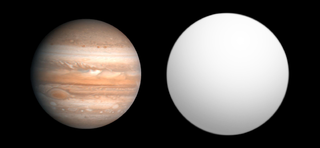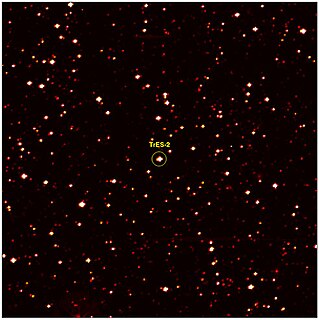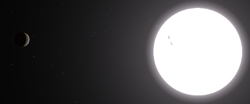GSC 02652-01324 is an orange dwarf main sequence star approximately 523 light-years away in the constellation of Lyra.
OGLE-TR-111 is a yellow dwarf star approximately 5,000 light-years away in the constellation of Carina. Having an apparent magnitude of about 17, this distant and dim star has not yet been cataloged.
OGLE-TR-132 is a distant magnitude 15.72 star in the star fields of the constellation Carina. Because of its great distance, about 4,900 light-years, and location in the crowded field it was not notable in any way. The spectral type of the star is type F. A yellow-white, very metal-rich dwarf star, it is slightly hotter and more luminous than the Sun.
HD 17156, named Nushagak by the IAU, is a yellow subgiant star approximately 255 light-years away in the constellation of Cassiopeia. The apparent magnitude is 8.17, which means it is not visible to the naked eye but can be seen with good binoculars. A search for a binary companion star using adaptive optics at the MMT Observatory was negative.
OGLE-TR-113 is a dim, distant magnitude 16 binary star in the star fields of the constellation Carina. Because of its distance of about 1170 light years, and location in a crowded field it was not notable in any way. Spectral type of the star is type K dwarf star, slightly cooler and less luminous than the Sun.
OGLE-TR-182 is a dim magnitude 17 star far off in the constellation Carina at a distance of approximately 12,700 light years.
OGLE-TR-211 is a distant magnitude 14 star located about 5,700 light years away in the constellation of Carina.

OGLE-TR-113b is an extrasolar planet orbiting the star OGLE-TR-113.
CoRoT-4 is a yellow-white dwarf main-sequence star in the constellation Monoceros.
HAT-P-4 is a wide binary star consisting of a pair of G-type main-sequence stars in the constellation of Boötes. It is also designated BD+36°2593.

OGLE2-TR-L9b is an extrasolar planet discovered by three undergraduate students from Leiden University, Netherlands. The planet is about 4.5 times as massive as Jupiter and is the first discovered planet orbiting a fast rotating hot star.

OGLE-TR-111b is an extrasolar planet approximately 5,000 light-years away in the constellation of Carina. The planet is currently the only confirmed planet orbiting the star OGLE-TR-111.

OGLE-TR-132b is an extrasolar planet orbiting the star OGLE-TR-132.

The Gamma-Ray Burst Optical/Near-Infrared Detector (GROND) is an imaging instrument used to investigate Gamma-Ray Burst afterglows and for doing follow-up observations on exoplanets using transit photometry. It is operated at the 2.2-metre MPG/ESO telescope at ESO's La Silla Observatory in the southern part of the Atacama desert, about 600 kilometres north of Santiago de Chile and at an altitude of 2,400 metres.

CoRoT-1 is a yellow dwarf main sequence star similar to our Sun. The star is located approximately 2,630 light-years away in the constellation of Monoceros. The apparent magnitude of this star is 13.6, which means it is not visible to the naked eye; however, it can be seen through a medium-sized amateur telescope on a clear, dark night. The first exoplanet discovered in the course of the CoRoT mission orbits this star; it is considered to be a "hot Jupiter", and is approximately as massive as the planet Jupiter itself.

GSC 03549-02811, also known as Kepler-1) is a yellow main-sequence star similar to our Sun. This star is located approximately 704 light-years away in the constellation of Draco. The apparent magnitude of this star is 11.41, which means it is not visible to the naked eye but can be seen with a medium-sized amateur telescope on a clear dark night. The age of this star is about 5 billion years.
GSC 03089-00929 is a magnitude 12 star located approximately 760 light-years away in the constellation of Hercules. This star is a G type main sequence star that is similar to but slightly cooler than our sun. This star is identified in SIMBAD as a variable star per the 1SWASP survey.
GSC 02620-00648 is a double star in the constellation Hercules. The brighter of the pair is a magnitude 12 star located approximately 1400 light-years away. This star is about 1.18 times as massive as the Sun.
HAT-P-8 is a magnitude 10 star located 750 light-years away in Pegasus. It is a F-type star about 28% more massive than the Sun. Two red dwarf companions have been detected around HAT-P-8. The first has a spectral type of M5V and has a mass of 0.22 M☉. The second is even less massive, at 0.18 M☉, and its spectral type is M6V.







